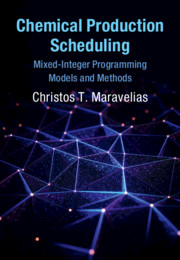Book contents
- Chemical Production Scheduling
- Cambridge Series in Chemical Engineering
- Chemical Production Scheduling
- Copyright page
- Dedication
- Contents
- Preface
- Part I Background
- Part II Basic Methods
- Part III Advanced Methods
- 8 Network Environment: Extensions
- 9 Continuous Processes
- 10 Periodic Scheduling
- 11 Multiperiod Blending
- Part IV Special Topics
- Index
- References
10 - Periodic Scheduling
from Part III - Advanced Methods
Published online by Cambridge University Press: 01 May 2021
- Chemical Production Scheduling
- Cambridge Series in Chemical Engineering
- Chemical Production Scheduling
- Copyright page
- Dedication
- Contents
- Preface
- Part I Background
- Part II Basic Methods
- Part III Advanced Methods
- 8 Network Environment: Extensions
- 9 Continuous Processes
- 10 Periodic Scheduling
- 11 Multiperiod Blending
- Part IV Special Topics
- Index
- References
Summary
In Chapter 1, we discussed how the market environment affects the scheduling of manufacturing facilities primarily because the volume and variability of product demand determine the regularity and frequency in which scheduling is performed. The production of high-volume products with relatively constant demand or high-volume intermediates can be based on demand forecasts, rather than specific orders. If the forecasts do not exhibit significant fluctuations over time, one approach is to generate a schedule that can be repeated periodically, to maintain a certain level of stock. The process of generating such schedules, which is the topic of the present chapter, is termed periodic scheduling. In Section 10.1, we use the single-unit environment to motivate the need for periodic scheduling, define relevant notation, and present some preliminary concepts and models. In Section 10.2, we use the single-stage environment to discuss some additional concepts and one formulation. Finally, in Section 10.3, we present periodic scheduling in network environments.We consider processes without any of the processing features discussed in Chapter 8.
- Type
- Chapter
- Information
- Chemical Production SchedulingMixed-Integer Programming Models and Methods, pp. 233 - 260Publisher: Cambridge University PressPrint publication year: 2021

